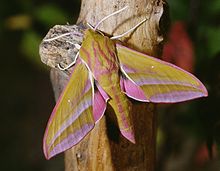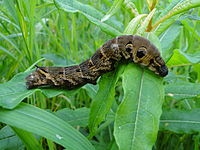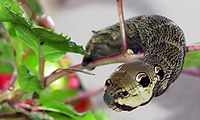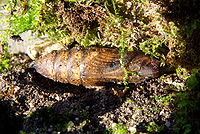- Deilephila elpenor
-
Deilephila elpenor 
Scientific classification Kingdom: Animalia Phylum: Arthropoda Class: Insecta Order: Lepidoptera Family: Sphingidae Genus: Deilephila Species: D. elpenor Binomial name Deilephila elpenor
(Linnaeus, 1758)[1]Synonyms - Sphinx elpenor Linnaeus, 1758
- Chaerocampa lewisii Butler, 1875
- Elpenor vitis Oken, 1815
- Chaerocampa elpenor alboradiata Lambillion, 1913
- Chaerocampa elpenor cinerescens Newnham, 1900
- Deilephila elpenor argentea Burrau, 1950
- Deilephila elpenor philippsi Niepelt, 1921
- Deilephila elpenor tristis Lempke & Stolk, 1986
- Deilephila elpenor vautrini Austaut, 1907
- Eumorpha elpenor clara Tutt, 1904
- Eumorpha elpenor obsoleta Tutt, 1904
- Eumorpha elpenor pallida Tutt, 1904
- Eumorpha elpenor unicolor Tutt, 1904
- Eumorpha elpenor virgata Tutt, 1904
- Pergesa elpenor daubi Niepelt, 1908
- Pergesa elpenor distincta Meyer, 1969
- Pergesa elpenor hades Rebel, 1910
- Pergesa elpenor lugens Niepelt, 1926
- Pergesa elpenor scheiderbaueri Gschwandner, 1924
- Pergesa elpenor szechuana Chu & Wang, 1980
Deilephila elpenor, known as the Elephant Hawk-moth, is a large moth of the Sphingidae family.
Contents
Range
The species is found throughout Britain and Ireland. Its range extends across Europe, Russia, and into China, northern parts of the Indian subcontinent, Japan and Korea (though not Taiwan). Introduced specimens have been found in British Columbia. In most of their range, the adults are seen from May to July and the caterpillars from July to September, when they pupate. However in some parts of the Mediterranean and China the adults may be seen from April on, sometimes having two broods in a year.
Appearance
Larva
The larva is about 75 millimetres (3.0 in) long, green and brown in colour. Like most hawk moth caterpillars, they have a backward curving spine or "horn" on the final abdominal segment. The anterior of the caterpillar appears to have the shape of a trunk-like snout. It is this elephant look, rather than its large size, that gives the moth its name. When startled, the caterpillar draws its trunk into its foremost body segment. This posture resembles a snake with a large head and four large eye-like patches. Caterpillars are preyed upon by birds, but these shy away (at least for some time) from caterpillars in "snake" pose. It is not known whether the birds take the caterpillar to actually resemble a snake, or are frightened by the sudden change of a familiar prey item into an unusual and boldly-patterned shape.[2]
The preferred food plants of the caterpillar are willowherb (Epilobium) and bedstraw (Galium), though it will also take fuchsias.
Adult
The imago (adult) feeds at night, and often takes nectar from garden plants like Honeysuckles (Lonicera) and petunias, so it is quite often seen in urban settings in the evening. The moth typically has a wing span of 50–70 mm (2.0–2.8 in). It is spectacularly coloured, seeming to shimmer with green and red when in motion. The adult moths are eaten by some species of bats.
Night vision
This species possesses good night or scotopic vision. Its eye includes two different kinds of ommatidium; each contains nine light sensitive cells, of which seven contain a pigment whose absorption spectrum peaks in the green part of the spectrum, but in one type the remaining two receptors have peak absorption in the blue and in the other type they have peak reception in the ultra violet. The moth therefore has the cellular prerequisites for trichromatic colour vision. Adults have been shown to be capable of making colour discriminations at night-time levels of illumination, and they sustain these discriminations despite changes in the spectral content of the incident light; that is, they show colour constancy.[3]
Subspecies
Two subspecies, Deilephila elpenor elpenor and Deilephila elpenor lewisii, were recognised in the past, but they are no longer regarded as well distinguished. Similarly the subspecies Deilephila elpenor szechuana is now thought to be a synonym for Deilephila elpenor elpenor. The subspecies Deilephila elpenor macromera, found in southern China, northern India, Bhutan and Myanmar, is still regarded as distinct.
The related species, the Small Elephant Hawk-moth Deilephila porcellus and Chitral Elephant Hawk-moth Deilephila rivularis are similar but smaller and less colourful.
References
- ^ "CATE Creating a Taxonomic eScience - Sphingidae". Cate-sphingidae.org. http://www.cate-sphingidae.org/taxonomy/Deilephila/elpenor.html. Retrieved 2011-10-26.
- ^ Martin Stevens (2005). "The role of eyespots as anti-predator mechanisms, principally demonstrated in the Lepidoptera". Biological Reviews 80 (4): 573–588. doi:10.1017/S1464793105006810. PMID 16221330.
- ^ Almut Kelber, Anna Balkenius & Eric J. Warrant (2002). "Scotopic colour vision in nocturnal hawkmoths". Nature 419 (6910): 922–925. doi:10.1038/nature01065. PMID 12410310.
External links
- Genus and species account from A. R. Pittaway's authoritative "Spingidae of the Western Palaearctic" site.
- More images from the UK Virtual Field Guide
Categories:- Macroglossini
- Animals described in 1758
Wikimedia Foundation. 2010.



